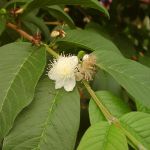| Common Name: |
Apple Guava |
| Other Names: |
Guava, Yellow Guava |
| Botanical Name: |
Psidium guajava |
| Genus: |
Psidium |
| Family: |
Myrtaceae |
| Native Location: |
Tropical America; widely naturalized. |
| Cultivation: |
Well-drained soil, pH4.8-8, in sun, with humidity to 70 percent. Aphids and scale insects may damage foliage; under glass, whiteflies and thrips may be a problem. |
| Propagation: |
By seed sown when ripe; by semi-ripe cuttings, 12-16cm (5-6in) long during the growing season. Seedlings are prone to damping off. |
| Harvest: |
Fruits are picked when ripe ro culinary uses; unripe fruits are harvested for infusions. Leaves are collected as required for use in infusions. |
| Varieties: |
Beaumont
Has large round, pink-fleshed fruits with a mildly acid flavor.
Originated in Oahu, Hawaii. |
Red Indian
Has very aromatic, yellow, often pink-flushed fruits with sweet red flesh.
Originated in Florida in 1946. |
|
| Height: |
8m (25ft) |
| :Width |
7m (22ft) |
| Hardiness: |
Min. 18°C (64°F) |
| Parts Used: |
Leaves, fruits (occasionally bark or roots) |
| Properties: |
An astringent, antioxidant herb that has antibiotic effects. It controls bleeding and lowers blood sugar levels. Anti-carcinogenic and anti-HIV properties have been reported. |
| Medicinal Uses: |
Internally for diarrhea, dysentery, diabetes, feverish illnesses (notably malaria), and coughs. Externally for wounds, boils, and ulcers. Leaf infusions, occasionally decoctions of unripe fruits, bark or roots, are used for various complaints. |
| Culinary Uses: |
Ripe fruits are eaten raw, cooked, dried, and made into preserves (notably guava cheese), jellies, and chutneys; also juiced for drinks. |
| Bibliography: |
Encylopedia of Herbs by Deni Brown Copyright ©: 1995, 2001 Dorling Kindersley Limited pg 334
|
